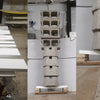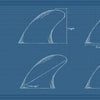Twin Fins Talk: The Ultimate Guide to Choosing Your Perfect Twin (part 2)
The surface area of fins for your surfboard
In this blogpost we will cover the surface area of the fins and how this is affecting your feeling and style while surfing. It is a very important aspect of fins and we'll see that we have a lot of options, but we'll classed them so you can find what's good for you!
The ‘’Area’’ of a fin is the surface area (measured in inch^2) of the fin that is in contact with the water. The area of a fin affects the speed, hold, and drive of your surfboard. In general, the larger the area of a fin, the more speed and hold you will get, but the less maneuverability you will have. The smaller the area of a fin, the less speed and hold it will generate, but it will release easier and be more maneuverable. Area is a very important aspect of a fin and your choice of size is closely related to your weight. Twin-fin surfboards usually have larger side fins than other fin setups, as they need more surface area to compensate for the lack of a center fin. However, the area of a fin also depends on the shape and size of your surfboard, your skill level, and the wave conditions.
Here are some things to look up when selecting fin size.
- Your weight affects the amount of force you apply on your fins, and a heavier surfer will require more fin area to get the same hold and drive as a lighter surfer.
- A wide tail board would benefit from a fin with more surface area while a pulled-in tail could hold with a smaller fin.
- The location of your surfboard’s fin boxes also influences the size of the fins you need. The more upfront fin boxes are, the looser your board will feel, so you may need a larger fin to balance. The nearer the fin boxes are to the back of the board, the tighter your board will feel, so you may need a smaller fin to compensate. (The distance from the fin boxes to the tail of a twin-fin surfboard usually varies from 6 to 11 inches at the back end of the fin box.)
- The condition of the waves also affects the size of the fin you need. In slower and softer waves, your fins will feel looser, so you may need a larger fin to hold and create more speed and lift. In faster and stronger waves, your fins will feel tighter, so you may need a smaller fin to create less drag and more control.
- Your skill level also impacts the size of the fin you need. If you are a beginner or intermediate surfer, you may need a larger fin to give you more stability and forgiveness. If you are an advanced or expert surfer, you can get around with a smaller fin to give you more responsiveness and a looser feel.
I examined all the twin fins that are currently offered by Futures, True Ames, and Captain Fin websites and classified them into three groups: the twin, the twin+1 (which also includes the twad and the NPJ quad that for me are twin+2 and are in the same family), and the keel fin. I separated them because they have different functions, sensations, and board preferences. I arranged the fins according to their surface area to show how much hold they offer and grouped them into four categories that I created based on an average fin size: Small, Medium, Large, and X-large.
Size
Here is a rule of thumb to size your fins according to your weight, but you must consider all the other aspects. If you have questions, contact us for help.
Small = 100lbs-160lbs
Medium = 145lbs-175lbs
Large = 165-200
X-Large 180+
Twin fins
Let’s begin with the twin fin. Some of these are fins that come with a twin+ trailer, but they can be rided as true twin, so we ignored the area of the small center fin for this category and considered that they were surfed without the center fin. Use these as guidelines and refer to the previous explanation to find your range. You can also ask your shaper for advice (contact us).
Small
- Futures DJ fiberglass twin (18.55)
- True Ames Album Gemini Twin 5.3 (18.7)
- Captain Fin CF twin Especial (18.95)
- True Ames TA twin 5.1 (18.97)
Medium
- Futures Blackstick twin (19.04)
- Futures Akila Fiberglass (19.1)
- Captain Fin Tyler Warren twin FG (19.28)
- Futures Mayhem Evil twin (19.34)
- Captain Fin Panda Twinzer (19.4)
- Futures T2 fiberglass twin (19.48)
- True Ames Stussy Roots (19.57)
- Futures Zack Flores fiberglass twin (19.58)
- Futures Rasta Twin (19.76)
- Futures T1 twin (19.79)
- Futures Pukas Twin (19.88)
- Futures Al Merrick Twin (20.43)
- Futures TP twin (20.45)
- Captain Fin Christenson Twin (20.46)
- True Ames Channel Island Twin (20.47)
- True Ames Mandala V Twin (20.53)
- True Ames Stussy Power Twin (20.8)
- True Ames Album Gemini twin 5.45 (20.8)
- Captain Fin Troy Elmore Twin (21.1)
Large
- Futures Mayhem Evil twin (21,25)
- Captain Fin Panda twin (21.28)
- Captain Fin Tyler Warren twin ESP (21.31)
- True Ames TA twin (21.27)
- Futures Pyzel bobcat twin (21.73)
- Futures Son of cobra twin (21.75)
- True Ames Lovelace piggyback (21.96)
- True Ames Album Twin (21.96)
- Captain Fin NEAL PURCHASE JR. "NPJ" (22.09)
- Captain Fin Chippa Especial (22.09)
- Captain Fin Mickey Feb twin (22.35)
X-Large
- Futures EN fiberglass twin (22.75)
- Futures Glenn Pang (22.8)
- True Ames Mackie big twin (23.27)
- Futures Britt Merrick Twin (23.58)
Twin+1 fins
Next, if you include the trailer on your twin + trailer, this is how we sized them. We added the area of one front fin and the area of the trailer because we think that this reflects the best what is in contact with the water when you surf a wave.
Small
- Captain Fin CF twin Especial (25.65)
- Captain Fin Former Twad (26.04)
- Futures Pukas twin+1 (26.05)
- Futures Mayhem Evil twin+1 medium (26.56)
Medium
- Captain Fin Panda twin+1 (26.6)
- Captain Fin Panda twinzer (26.93)
- True Ames Stussy Roots twin + trailer (27.38)
- Futures TP twin+1 (27.49)
- Futures Rasta twin+1 (27.66)
- Futures T1 twin+1 (27.69)
- Captain Fin Tyler Warren twin + trailer FG (28.16)
- Futures Mayhem Evil twin+1 large (28.47)
- Futures Glenn Pang twin+1 (29.36)
- Futures Al Merrick twin +1 (29.61)
Large
- Futures Blackstick twin+1 (30.04)
- Captain Fin Troy Elmore twin (20.16)
- Captain Fin Tyler Warren twin ESP (30.48)
X-Large
- Captain Fin NEAL PURCHASE JR. "NPJ" QUARTET (31)
- Captain Fin Chippa Especial (31)
- True Ames Mackie big twin+trailer (32.03)
- True Ames Power trailer+ twin fins (33.42)
Keel fins
Keel fins have a wide base and a swallow depth, they are usually used on fishes surfboards and bigger boards that require a lot of surface area and that wants to go down the line while still releasing.
Small
- True Ames Lovelace piggyback keel (21.96)
- Future K2 Fiberglass keel (22.25)
- Futures Album mod keel (22.27)
Medium
- True Ames Mackie sidecut fish keel (23.47)
- True Ames performance keel (23.51)
- Captain Fin Christenson keel especial (24.18)
- True Ames Danny Hess Noriega Twin (keel) (24.56)
- Futures Rasta Keel (24.59)
- Captain Fin Jeff McCallum keel (24.7)
- True Ames Lovelace Keel (24.71)
Large
- True Ames Tyler warren modern keel (25.25)
- True Ames Wayne Rich nightmare keel (25.3)
- Futures Machado keel (25.39)
- Futures Al Merrick Keel (AMK) (25.54)
- Captain Fin CF Keel (25.99)
- Captain Fin Mickey February Keel (25.99)
X-Large
- True Ames Channel Islands keel (26.07)
- True Ames Hobie Fish (26.16)
- True Ames Troy Elmore keel (27.12)
Next
I think that those infos will help you find a fin that will suit your weight, board and the conditions you are surfing, but in the next blog post, we will talk about the height of your fins, the base width and the rake, this will give you a much better understanding of the general template of the fin and it will give you a more precise idea of how a fin will respond.





